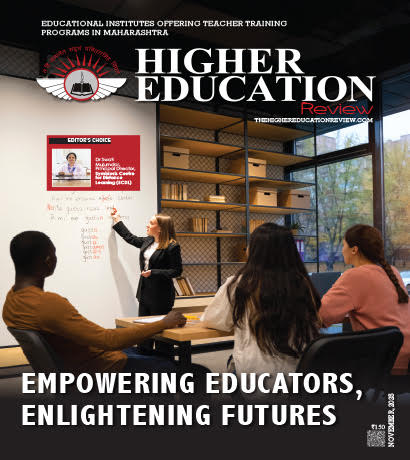Unleashing the Potential of Digital Education: A Closer Look at Online Learning
 In a conversation with Keerthana, Correspondent, Higher Education Review Magazine, Parimala Veluvali, Director and Associate Professor at Symbiosis School for Online and Digital Learning, shared her views and thoughts on what initiatives or methods are employed to enhance student interaction, participation, and collaboration in online learning environments. Parimala Veluvali is an academic with over thirteen years of teaching experience. She is also a fellow member of the Institute of Company Secretaries of India, and she has authored research papers in Scopus and Web of Science-indexed journals. Below are the excerpts from the exclusive interview –
In a conversation with Keerthana, Correspondent, Higher Education Review Magazine, Parimala Veluvali, Director and Associate Professor at Symbiosis School for Online and Digital Learning, shared her views and thoughts on what initiatives or methods are employed to enhance student interaction, participation, and collaboration in online learning environments. Parimala Veluvali is an academic with over thirteen years of teaching experience. She is also a fellow member of the Institute of Company Secretaries of India, and she has authored research papers in Scopus and Web of Science-indexed journals. Below are the excerpts from the exclusive interview –
How can we plan to adapt and evolve online learning programs to meet the changing needs and expectations of students and the educational landscape?
Access to good quality education is becoming increasingly important and is the key to empowerment. Online education is progressively becoming popular not just among working professionals but also among undergraduate students, in view of the flexibility and learner centricity that it offers. It provides prospects to learners to upskill and acquire the same kind of knowledge, skills, and a recognised degree as prevalent in the conventional mode, in an affordable and self-paced manner. Learners have the opportunity to pursue education simultaneously while they work or acquire a dual degree in view of the enormous opportunities that digitisation, technology and educational reforms have enabled.
Students enrolled in an online programme have the same kind of expectations with regard to academic quality, as they have from a conventional programme, and it is important that their expectations are met. To the extent possible, online education must replicate the experience of on-campus conventional education for the learners in terms of curriculum design and academic rigour. The curriculum must undergo a periodic review through a consultative process with the stakeholders. This will ensure that the academic offerings remain current and value-giving. The quality of the online programmes also depends on the quality of the instructors, engaging content, a dynamic and user-friendly learning management system and student engagement.
Much of the value of an on-campus programme also comes from learning outside the classroom through participation in student activities, collaborative tasks, peer learning opportunities and top-up learning through guest lectures, webinars and participation in competitions and fests. These must also be replicated in the online offerings. Advancements in technology have made it possible to conduct most of the activities online. This will also ensure a sense of belongingness and participation among the learners. Student centricity is the key to all aspects of the online programme delivery. In addition to rich academic content and delivery, the programmes must also make room for an outcome-based approach with assessment and attainment of programme outcomes integrated into the curriculum design. The online offerings must also make way for providing personalized, engaging, and relevant education to map with the students ’ career goals.
What initiatives or methods are employed to enhance student interaction, participation, and collaboration in online learning environments?
A primary challenge encountered in the delivery of an online programme is the lesser scope for student interaction and room for collaboration as compared to conventional programmes. Having said that, digitisation and innovations in technology have made it possible to actively engage with online learners and involve them in collaborative learning activities. Content creation tools such as Padlet, online discussion tools, discussion forums online quizzing tools, gamification, and game-based learning platforms offer many opportunities for enhancing student engagement and collaboration. Collaboration can also be infused through group-based projects and activities. Incorporating instructional design principles such as active learning, peer collaboration, videos, animations and simulations, monitoring students’ activity, and providing personalized feedback go a long way in providing the students a good learning experience.
According to you, what steps are taken to ensure that faculty are well-trained and equipped to deliver effective online courses?
The pedagogy of online teaching is different from traditional classroom teaching, albeit the content taught is the same. Faculty must be trained on the instructional strategies for online learning. Some of the key aspects on which training is required to be provided include maintaining a good screen presence, creating engaging content through multimedia tools, learner-centric instruction, planning for the sessions, managing adult learners and the four-quadrant approach of online delivery. Faculty has to be trained in class management and query handling in live sessions as the class size is bigger and more diverse than in traditional classes. Training is also required to be provided on understanding and appreciating the learning diversity in class.
How can we ensure that online learning is accessible and inclusive for all students, including those with disabilities or limited access to technology?
The efficacy of an online programme is also determined by the degree to which it is inclusive and accessible to all, including learners with special needs and those who may have limited access to technology. The key attributes of inclusive online learning are (1) the Presentation of learning content in a manner that is understood and engaging for all (2) the provision of equal opportunities for all to participate and attain the learning outcomes, irrespective of learning diversities. This further requires that the learning content which may include the study learning material, development of the asynchronous content and synchronous engagement must incorporate universal design for learning principles. Presentation of content through a blend of text, visual and auditory content and interface elements will ensure appeal and accessibility to learners with special learning needs and disabilities. A dynamic learning management system that facilitates the use of whiteboards, intuitive navigation, adjustable font and text sizes, and audio descriptions, will ensure a great learning experience for diverse learners.
To make online learning more accessible to those with limited use of technology, higher education institutions may as a part of social responsibility provide access to broadband, smartphones, and laptops for better reach to quality education to marginalised communities.
The United Nations under SDG 4 has mandated the elimination of discrimination and provision of easy access to quality education. Online learning can be the catalyst in bringing about this transformation.

